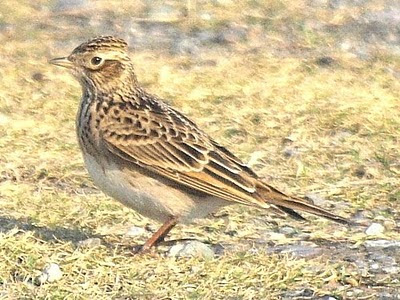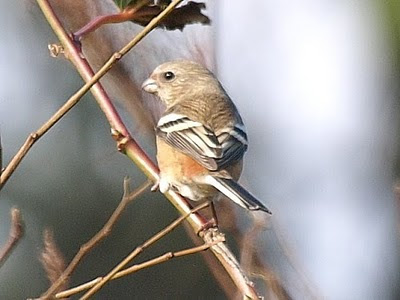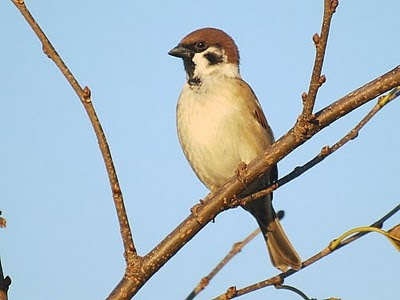7/11/10: A lovely calm and clear dawn. Walked the Dragon’s Pool area with Rob but nothing new was in evidence though small numbers of Dusky Thrushes and Hawfinches were seen moving south. Later in the morning several Waxwing flocks were seen with some Japanese Waxwings being identified amongst them. The female Siberian Rubythroat remained at Tsukasa fields as did the Siberian Accentor but generally there were far fewer birds in evidence. Due to an approaching weather system we decided to leave the island a day ahead of schedule for fear of the ferry being cancelled. On our arrival at Wajima Kotubushi kindly drove us to the Route Inn where we checked in and then twitched Rob’s Snow Bunting just to the east.




Juvenile Skylark at Tsukasa
Brazil (2009) states that no convincing criteria separating A.a. japonica from all other forms of Eurasian Skylark have been published. That said, the above individual's long primary projection accords well with the description and illustration of Eurasian Skylark A.a. lonnbergi contained therein and longer than that of the images of A.(a.) japonica at:

Rustic Bunting at Tsukasa
Brazil (1991) only lists the eastern form E.r. latifascia for Japan although Byers et al. (1995) state the differences between the two forms are slight. Ageing is difficult in Autumn as during June to September juveniles undergo a partial post-juvenile moult and adults a post-breeding moult.


First-winter Masked Bunting E.(s.) personata at Tsukasa
Byers et al. (1995) includes E.s. parvirostris of Central Siberia in the ‘northern group’ of relatively small size and relatively small-billed forms. They describe this form as a small form. Pale with little or no streaking on flanks, and reduced streaking on crown and mantle. Fine bill, with almost straight culmen. BWP states black streaks on cap of female and on flanks of both sexes virtually absent, streaks on mantle and scapulars short and narrow.
Based on its almost straight culmen we tentatively assigned this individual to parvirostris. That said, it did not appear noticeably small, in fact, larger than what we were attributing to pyrrhulina but BWP doesn’t include comparative data for parvirostris. Its pointed tail feathers suggest a first-winter and its somewhat diffuse head pattern a female.
Species noted:
Great Crested Grebe 1
Streaked Shearwater 2Cormorant 5
Eastern Reef Egret 2
Great Egret 1
Grey Heron 1
Mallard 1
Black-eared Kite 1 Hegura / 20 Wajima
Japanese Sparrowhawk 1
Sparrowhawk 1
Merlin 1
Peregrine 2
Black-tailed Gull 50 Hegura / 100 Wajima
Kamchatka Gull 4 Wajima
Vega Gull 1
Slaty-backed Gull 2 Hegura / 10 Wajima
Rock Dove 2
Rufous Turtle Dove 3
Skylark 8 Hegura / 1 Wajima
Olive-backed Pipit 3
Siberian Buff-bellied Pipit 5
Black-backed Wagtail 3
Brown-eared Bulbul 1
Japanese Waxwing 3
Waxwing 2
Waxwing sp. 25
Siberian Accentor 1
Siberian Rubythroat 1 female
Daurian Redstart 15
Blue Rock Thrush 3
Dusky Thrush 30, 6S
Japanese Bush Warbler 2
Goldcrest 10
Eastern Great Tit 1
Japanese White-eye 5
Eastern Rook 2
Large-billed Crow 4
White-cheeked Starling 6
Tree Sparrow 10 Wajima
Brambling 10
Oriental Greenfinch 1
Siskin 2
Mealy Redpoll 1 Hegura / 5 Wajima
Long-tailed Rosefinch 2
Bullfinch 3
Japanese Grosbeak 3
Hawfinch 60, 8S
Grey Bunting 1
Masked Bunting 1
Elegant Bunting 5
Rustic Bunting 5
Reed Bunting 1
Snow Bunting 1 Wajima






















